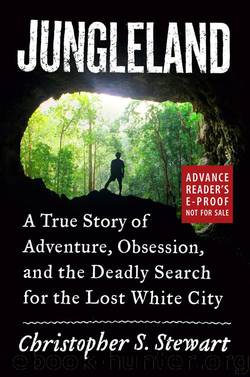Jungleland: A Mysterious Lost City, a WWII Spy, and a True Story of Deadly Adventure by Christopher Stewart

Author:Christopher Stewart
Language: eng
Format: mobi, epub
Tags: Non-Fiction
ISBN: 9780061802546
Publisher: Harper
Published: 2013-01-08T00:00:00+00:00
UNCORRECTED E-PROOF—NOT FOR SALE
HarperCollins Publishers
..................................................................
“BEYOND HOPE”
WITHOUT EVIDENCE OF the ancient city, Morde turned again to rumor. The first story of Ciudad Blanca came from a man named Timoteo Rosales. When he encountered Rosales, however, is unknown; no date was recorded in Morde’s journals. What is known is that Rosales worked as a rubber cutter, during which he spent weeks wandering around the unmapped parts of the region, extracting from tree trunks the gummy white fluid known as latex. That fluid, after Rosales humped it to a river, was later turned into chewing gum and tires, among other things. He told Morde that it was in 1905, during a trek from the Río Paulaya to the Río Plátano—in the middle of the forest, far from any settlements—he looked up and saw stone “columns.” He believed it was the lost city, though he hadn’t stopped to linger over it. At another point in his travels, Morde met a man who claimed to have stumbled upon the ruins in 1898, at the place where the heads of the Plátano, Paulaya, and Wampu rivers come together. The man called the ruins “the White City”—the first and only mention of the name in Morde’s logbooks. That was a big clue, but the area at the river heads covered more than a hundred square miles. They needed more to go on.
In time, they did discover traces of the ancient people who had dwelled there. From under dirt and rocks, they dug up six stone flutes, numerous razor blades, and stone household items such as pots, spoons, and grinding slabs. They also uncovered tiny religious idols, with faces contorted by weather and time, and small masks resembling monkey faces. All of it made them wonder: could the people who made these things have inhabited the lost city?
Most amazingly, they encountered earth-covered mounds, rising like small, toppled buildings. Indians they met described the ancient people who lived in these deep parts as master stone builders. Because of this, Morde wrote of the city, “the [Indians] insisted, much had been preserved.” He also heard about a long-staired approach to the city, paved in bleached stones and flanked by “larger than life statues of frogs, crocodiles and monkeys.”
The dramatic description echoed other outlandish accounts of lost cities. The conquistador Francisco de Orellana had once described a place he’d seen on his search for El Dorado in 1542. “There was one town that stretched for 15 miles without any space from house to house which was a marvelous thing to behold,” he observed at one point. “There were many roads here that entered into the interior of the land, very fine highways.” He wrote too of “very large cities that glistened in white.”
The most shocking thing Morde heard during those weeks was a detail of the White City’s center. “At the heart of the place was a temple,” an Indian told him, “with a high stone platform on top of which rose the towering the statue of the Monkey God himself.”
The city might be around any bend, over any hill.
Download
Jungleland: A Mysterious Lost City, a WWII Spy, and a True Story of Deadly Adventure by Christopher Stewart.epub
This site does not store any files on its server. We only index and link to content provided by other sites. Please contact the content providers to delete copyright contents if any and email us, we'll remove relevant links or contents immediately.
How to Read Water: Clues and Patterns from Puddles to the Sea (Natural Navigation) by Tristan Gooley(2873)
Full Circle by Michael Palin(2780)
Into Thin Air by Jon Krakauer(2711)
How to Read Nature by Tristan Gooley(2668)
The Lost Art of Reading Nature's Signs by Tristan Gooley(2288)
In Patagonia by Bruce Chatwin(2275)
Don't Sleep, There Are Snakes by Daniel L. Everett(2220)
City of Djinns: a year in Delhi by William Dalrymple(2139)
L'Appart by David Lebovitz(2123)
The Songlines by Bruce Chatwin(2115)
Venice by Jan Morris(2055)
The Big Twitch by Sean Dooley(2047)
A Thousand Splendid Suns by Khaled Hosseini(2005)
Tokyo Geek's Guide: Manga, Anime, Gaming, Cosplay, Toys, Idols & More - The Ultimate Guide to Japan's Otaku Culture by Simone Gianni(1949)
A TIME OF GIFTS by Patrick Leigh Fermor(1852)
Come, Tell Me How You Live by Mallowan Agatha Christie(1772)
The Queen of Nothing by Holly Black(1760)
INTO THE WILD by Jon Krakauer(1730)
Iranian Rappers And Persian Porn by Maslin Jamie(1713)
